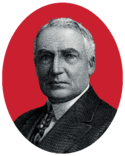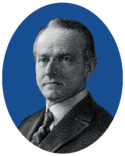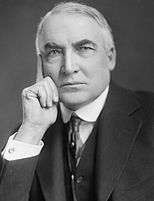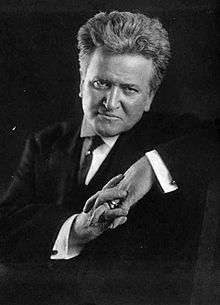1920 Republican National Convention
|
1920 presidential election | |
|
Nominees Harding and Coolidge | |
| Convention | |
|---|---|
| Date(s) | June 8–12, 1920 |
| City | Chicago, Illinois |
| Venue | Chicago Coliseum |
| Candidates | |
| Presidential nominee |
Warren G. Harding of Ohio |
| Vice Presidential nominee |
Calvin Coolidge of Massachusetts |
The 1920 National Convention of the Republican Party of the United States nominated Ohio Senator Warren G. Harding for President and Massachusetts Governor Calvin Coolidge for Vice President. The convention was held in Chicago, Illinois, at the Chicago Coliseum from June 8 to June 12, 1920.
Many Republicans sought the nomination, including General Leonard Wood, Illinois Governor Frank Lowden and California Senator Hiram Johnson. Dark horse Harding was nominated at the convention, however. Many wanted to nominate Wisconsin Senator Irvine L. Lenroot for Vice President, but Coolidge was nominated instead, because he was known for his response to the Boston Police Strike in 1919.
The convention also adopted a platform opposed to the accession of the United States to the League of Nations.[1] The plank was carefully drawn up by Henry Cabot Lodge to appease opponents of the League such as Johnson, while still allowing for eventual American entry into the League.[2]
Republican candidates
-
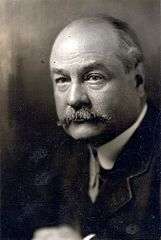
Columbia University President
Nicholas Murray Butler
of New York
At the start of the convention, the race was wide open.[3] General Leonard Wood, Illinois Governor Frank Lowden, and California Senator Hiram Johnson were considered the three most likely, nominees.[4] Ohio Senator Warren G. Harding had been a front-runner, but his star had faded by the time of the convention.[4] Many expected a dark horse to be chosen, such as Pennsylvania Governor William Cameron Sproul, Pennsylvania Senator Philander C. Knox, Kansas Governor Henry Justin Allen, Massachusetts Senator Henry Cabot Lodge, or 1916 nominee Charles Evans Hughes.[3] Sproul in particular had been gaining momentum at the expense of Lowden, the candidate of the conservative wing of the party.[4] The issue of joining the League of Nations took center stage at the convention, with some speculating that Johnson would bolt the party if the platform endorsed the League.[4] The convention adjourned for the night after four ballots produced no clear leader, and many states stuck to favorite-son candidates.[5]
As the balloting continued the next day, Wood, Lowden, and Johnson remained in the lead, and party leaders worked to find a candidate acceptable to both the progressive and conservative wings of the party.[6] Conservatives strongly opposed Wood, while Lowden was opposed by the progressive wing of the party.[6] Harding emerged as a moderately conservative candidate acceptable to the progressive wing of the party, and as the convention remained deadlocked, Harding emerged as a strong compromise candidate.[6] After the eighth ballot, the convention recessed, During the recess, Harding's managers lobbied Lowden's supporters and others to support Harding.[6] Harding was also helped by the fact that the Democrats had nominated James M. Cox of Ohio, and Republicans did not want to give the Democrats a home state advantage in electorally critical Ohio.[7]
Harding jumped into the lead on the ninth ballot, and clinched the nomination on the tenth ballot. Many thought that Johnson could have stopped the Harding movement by throwing his support behind Knox, who could have displaced Harding as the compromise candidate. Johnson disliked Harding's policies and disliked Harding personally, and was friends with Knox. However, Johnson never released his supporters, and Harding took the nomination.[6][7]
| Presidential Balloting, RNC 1920 | |||||||||||
|---|---|---|---|---|---|---|---|---|---|---|---|
| Ballot | 1 | 2 | 3 | 4 | 5 | 6 | 7 | 8 | 9 | 10 Before shifts | 10 After shifts |
| Warren G. Harding | 65.5 (6.67%) | 59 (6.00%) | 58.5 (5.95%) | 61.5 (6.25%) | 78 (7.93%) | 89 (9.04%) | 105 (10.67%) | 133 (13.52%) | 374.5 (38.06%) | 644.7 (65.52%) | 692.2 (70.35%) |
| Leonard Wood | 287.5 (29.22%) | 289.5 (29.42%) | 303 (30.79%) | 314.5 (31.96%) | 299 (30.39%) | 311.5 (31.66%) | 312 (31.7%) | 299 (30.39%) | 249 (25.3%) | 181.5 (18.45%) | 156 (15.85%) |
| Frank Lowden | 211.5 | 259.5 | 282.5 | 289 | 303 | 311.5 | 311.5 | 307 | 121.5 | 28 | 11 |
| Hiram Johnson | 133.5 | 146 | 148 | 140.5 | 133.5 | 110 | 99.5 | 87 | 82 | 80.8 | 80.8 |
| William C. Sproul | 84 | 78.5 | 79.5 | 79.5 | 82.5 | 77 | 76 | 76 | 78 | 0 | 0 |
| Nicholas Murray Butler | 69.5 | 41 | 25 | 20 | 4 | 4 | 2 | 2 | 2 | 2 | 2 |
| Calvin Coolidge | 34 | 32 | 27 | 25 | 29 | 28 | 28 | 30 | 28 | 5 | 5 |
| Robert M. La Follette | 24 | 24 | 24 | 22 | 24 | 24 | 24 | 24 | 24 | 24 | 24 |
| Jeter C. Pritchard | 21 | 10 | 0 | 0 | 0 | 0 | 0 | 0 | 0 | 0 | 0 |
| Miles Poindexter | 20 | 15 | 15 | 15 | 15 | 15 | 15 | 15 | 14 | 2 | 0 |
| Howard Sutherland | 17 | 15 | 9 | 3 | 1 | 0 | 0 | 0 | 0 | 0 | 0 |
| Herbert C. Hoover | 5.5 | 5.5 | 5.5 | 5 | 6 | 5 | 4 | 5 | 6 | 10.5 | 9.5 |
| Scattering | 11 | 9 | 7 | 9 | 9 | 9 | 6 | 6 | 5 | 5.5 | 3.5 |
Harding's nomination, said to have been secured in negotiations among party bosses in a "smoke-filled room," was engineered by Harry M. Daugherty, Harding's political manager, who after Harding's election became United States Attorney General. Before the convention, Daugherty was quoted as saying, "I don't expect Senator Harding to be nominated on the first, second, or third ballots, but I think we can afford to take chances that about 11 minutes after two, Friday morning of the convention, when 15 or 12 weary men are sitting around a table, someone will say: 'Who will we nominate?' At that decisive time, the friends of Harding will suggest him and we can well afford to abide by the result." Daugherty's prediction described essentially what occurred, but historians Richard C. Bain and Judith H. Parris argue that Daugherty's prediction has been given too much weight in narratives of the convention.
Vice Presidential nomination
Before Harding was nominated, Johnson, Kansas Governor Henry Justin Allen, Massachusetts Governor Calvin Coolidge, Wisconsin Senator Irvine Lenroot, Kentucky Governor Edwin P. Morrow, and Harding himself were all seen as possible vice presidential nominees.[6] Once the presidential nomination was finally settled, Harding and the party bosses asked Johnson to join the ticket as a progressive balance to Harding.[8] When Johnson turned down the offer, they approached Lenroot, who accepted.[8] However, when Illinois Senator Medill McCormick stood up to nominate Lenroot, several delegates began to shout for Coolidge.[8] A groundswell of support built up for Coolidge, who won the nomination over Lenroot.[8] Coolidge, who was not at the convention during the vice presidential nomination, agreed to join the ticket.[8]
| Vice Presidential Balloting, RNC 1920 | |
|---|---|
| Calvin Coolidge | 674.5 |
| Irvine L. Lenroot | 146.5 |
| Henry J. Allen | 68.5 |
| Henry W. Anderson | 28 |
| Asle J. Gronna | 24 |
| Hiram Johnson | 22.5 |
| Jeter C. Pritchard | 11 |
| Abstaining | 9 |
Source for convention coverage: Richard C. Bain and Judith H. Parris, Convention Decisions and Voting Records (Washington DC: Brookings Institution, 1973), pp. 200–208.
See also
References
- ↑ "Platform Adopted With Anti-Wilson League Plank; 'My Victory,' Says Johnson; Balloting Starts Today; Wood Men Claim the Lead; Midnight Move for Lowden". New York Times. 11 June 1920. Retrieved 9 October 2015.
- ↑ Miller, Karen A.J. (1999). Populist Nationalism: Republican Insurgency and American Foreign Policy Making, 1918-1925. Greenwood Publishing Group. pp. 87–89. Retrieved 9 October 2015.
- 1 2 "Platform Fights Starts as the Convention Opens; Johnson Flatly Demands Repudiation of the League; Apathy in the Convention; Lodge Permanent Chairman". New York Times. 9 June 1920. Retrieved 9 October 2015.
- 1 2 3 4 "Text of the Republican Platform, Except League Plank; Dispute Over That, and Threat of a Bolt by Borah; Wood Men See Gains; New Yorkers Balk at Butler Pledge". New York Times. 10 June 1920. Retrieved 9 October 2015.
- ↑ "Four Ballots, No Nomination, Wood Leads; Has 314 1/2 Votes, Lowden 289 and Johnson 140 1/2; Midnight Conferences Brings No Results". New York Times. 12 June 1920. Retrieved 9 October 2015.
- 1 2 3 4 5 6 "Harding Nominated for President on the Tenth Ballot at Chicago; Coolidge Chosen for Vice President". New York Times. 13 June 1920. Retrieved 9 October 2015.
- 1 2 Miller, pp. 90-91
- 1 2 3 4 5 "Calvin Coolidge, 29th Vice President (1921-1923)". US Senate. US Senate. Retrieved 9 October 2015.
Bibliography
External links
- Republican Party platform of 1920 at The American Presidency Project
- Harding acceptance speech at The American Presidency Project
| Preceded by 1916 Chicago, Illinois |
Republican National Conventions | Succeeded by 1924 Cleveland, Ohio |
